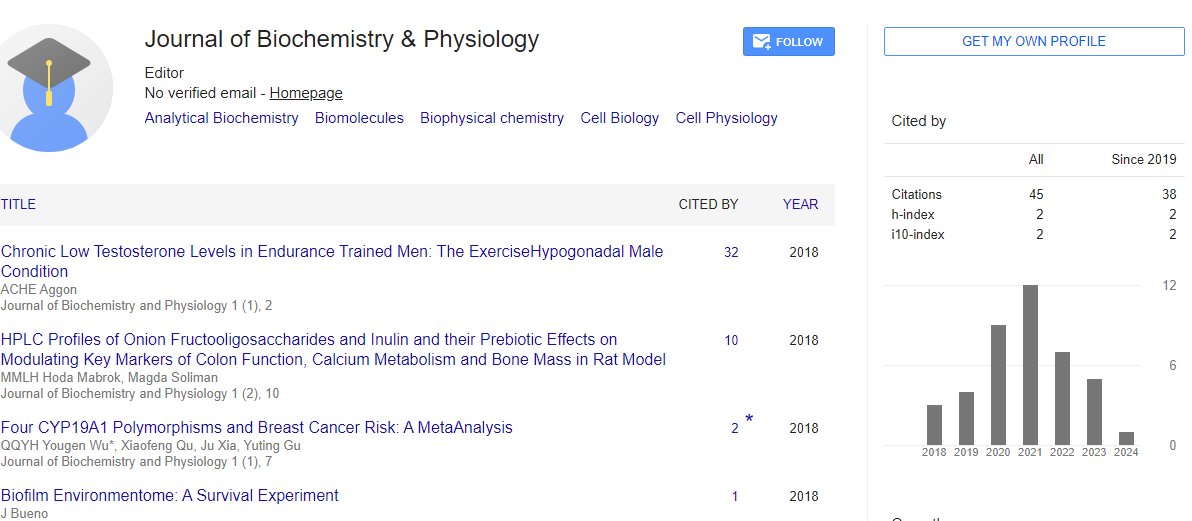Opinion Article, J Biochem Physiol Vol: 7 Issue: 2
Engineering Enzymes for Pharmaceutical Synthesis: From Drug Production to Biotherapeutics
Sun Li*
1Department Synthetic Biology, University of Chinese Academy of Sciences, Beijing, China
*Corresponding Author: Sun Li,
Department Synthetic Biology, University of
Chinese Academy of Sciences, Beijing 100049, China
E-mail: lisu@n.cn
Received date: 28 May, 2024, Manuscript No. JBPY-24-139481;
Editor assigned date: 30 May, 2024, PreQC No. JBPY-24-139481 (PQ);
Reviewed date: 13 June, 2024, QC No. JBPY-24-139481;
Revised date: 21 June, 2024, Manuscript No. JBPY-24-139481 (R);
Published date: 28 June, 2024, DOI: 10.4172/jbpy.1000163.
Citation: Li S (2024) Engineering Enzymes for Pharmaceutical Synthesis: FromDrug Production to Biotherapeutics. J Biochem Physiol 7:2.
Description
Enzymes, as nature’s biological catalysts, have been pivotal in facilitating biochemical reactions under conditions that are mild and environmentally friendly. Engineering enzymes for pharmaceutical synthesis has emerged as a transformative approach, enabling more efficient, selective, and sustainable production of drugs and biotherapeutics. Enzyme engineering, exploring its applications in pharmaceutical synthesis, and highlighting the benefits it brings to the production of Active Pharmaceutical Ingredients (APIs) and biotherapeutics.
Enzyme engineering aims to enhance the natural capabilities of enzymes by modifying their structure to improve properties such as stability, activity, and substrate specificity. The primary techniques employed in enzyme engineering include directed evolution, rational design, and computational modeling. By obtaining natural selection, directed evolution involves creating vast libraries of enzyme variants through random mutagenesis, followed by screening to identify those with desired traits. This method is particularly useful for evolving enzymes to catalyze reactions with new or non-natural substrates.
Informed by detailed structural and mechanistic knowledge of enzymes, rational design introduces specific mutations to achieve targeted improvements. This approach relies on a deep understanding of enzyme-substrate interactions and can be used to tailor enzymes for specific reaction conditions or substrate affinities. Computational methods use simulations and algorithms to predict the impact of mutations on enzyme structure and function. This can guide the design process, enabling the prediction and testing of enzyme variants in silico before experimental validation.
Enzyme engineering has revolutionized drug production by enabling the efficient synthesis of APIs. Engineered enzymes can perform complex chemical transformations with high selectivity, often under mild conditions and with fewer by-products compared to traditional chemical synthesis. Biocatalytic cascades integrate multiple enzymatic steps in a single process, allowing for the streamlined synthesis of complex drug molecules. Each enzyme in the cascade is optimized to function under compatible conditions, reducing the need for intermediate purification steps. Enzyme-catalyzed reactions are inherently more sustainable than traditional chemical methods. They often proceed at ambient temperatures and pressures, use benign solvents like water, and generate fewer toxic by-products. Engineering enzymes is also critical in the production of biotherapeutics, including monoclonal antibodies, vaccines, and enzyme replacement therapies. Modified enzymes can enhance cell culture processes, improve protein folding, and facilitate the development of novel post-translational modifications.
Engineered enzymes can achieve remarkable specificity and selectivity for substrates, leading to cleaner reactions and fewer side products. This is particularly important for synthesizing chiral drugs, where the production of a single enantiomer is essential for therapeutic effectiveness. Modifications can improve enzyme stability under various operational conditions, such as extreme pH or temperature, enhancing the robustness of enzymatic processes and extending the enzyme's operational lifespan. Enzyme engineering contributes to sustainable pharmaceutical manufacturing by enabling reactions that require less energy, generate fewer pollutants, and utilize renewable resources. This aligns with the principles of green chemistry and reduces the environmental footprint of drug production.
Conclusion
Engineering enzymes for pharmaceutical synthesis is at the forefront of creating more efficient, selective, and sustainable drug production processes. By enhancing enzyme properties through directed evolution, rational design, and computational modeling, scientists can develop innovative solutions for synthesizing APIs and biotherapeutics. These advancements not only improve the efficiency and sustainability of pharmaceutical manufacturing but also pave the way for new therapeutic possibilities.
 Spanish
Spanish  Chinese
Chinese  Russian
Russian  German
German  French
French  Japanese
Japanese  Portuguese
Portuguese  Hindi
Hindi 